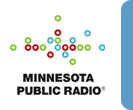 |



 |
Have ideas on how to use the news and other featured content on Sound Learning? What services and features would you like Sound Learning to provide?
Tell us how you use this site, what you like and dislike about it, what else you'd like to see here-anything. Help us help you.
Send us your comments or ideas for using and improving Sound Learning.
Sign up for our
monthly newsletter (September–May) >>
|

|  |

Searching for current news, information, and cultural programming? Looking for ways to ensure your students are doing quality research from credible sources? Sound Learning is a site designed exclusively to help teachers access up-to-date text and audio from Minnesota Public Radio's programming. It's your entry into the quality, reliability and depth you have come to expect from Minnesota Public Radio.
"Sound Learning" is more than a play on words. Sound Learning offers concrete connections between Minnesota Public Radio programming and current academic standards, a technical guide to help you access audio files, and suggestions for effective learning strategies. The addition of an audio component presents real advantages for those learners accessing the stories on this Web site. The ability to listen to a story as well as read it enhances the development of the reading/learning strategies described above. Audio versions of a text present several advantages:
- Students are able to perceive the tone of a story and detect the emotions of the people featured in a story; as a result they are better able to make perceptive inferences while reading.
- Student imaginations are stimulated by the voices and the sounds featured in an audio clip; their abilities to construct mental images of what they are reading is greatly facilitated by hearing the story as they encounter the words of a text. This is especially crucial for struggling readers or readers who are English language learners.
- Students gain valuable assistance with difficult vocabulary; they hear unfamiliar words pronounced that they would otherwise merely see in print. Hearing these words in context also assists readers with hypothesizing probable meanings. For struggling readers, as well as English language learners, hearing difficult words as they read provides immeasurable support as well as building a momentum for reading that is not constantly waylaid by challenging vocabulary.
- Student motivation to read is encouraged; we all enjoy listening to stories and being "read to" brings back fond memories from our youth. It is no accident that books on tape are widely popular today, and listening to a talented reader interpreting the words on a page is a highly pleasurable experience. Students will find the drama of stories, and the emotions expressed by individuals interviewed in an audio clip, to be more dramatic and engaging than from merely encountering the words of a text.
- Students who process information and ideas better through auditory rather than visual forms will find the audio components to stories more definitely tailored to their learning styles. They will have the option of both hearing and reading the stories, which will reinforce their learning.
- Students will have more variety in the means of their learning. A clear advantage of technology is that students will have multiple methods of accessing useful information. The audio components to sound learning underscore unique features that technology can add to classroom routines. Students are able to draw upon multiple senses as they become truly immersed in learning situations.
- Finally, students learn about the specific genre of writing encompassed by audio stories. These texts were written to be heard. As a result, the authors make choices in their writing that emphasize language and pacing that works especially well in a listening context. The texts are more powerful when listening is combined with reading.
Minnesota Public Radio understands the time crunch educators face as well as the value of credible, current information about the world, the region, and the arts. We've designed the guide to Sound Learning with your needs in mind, and we've enlisted help from educators across Minnesota to help us make Sound Learning as useful to you as we possibly can.
Materials posted on the Sound Learning web pages are protected by copyright. As the copyright owner, Minnesota Public Radio grants permission for educators to reproduce Sound Learning resources for use in classroom settings. Please be sure to include all the credits that you find on the site. For permission to use the resources in other contexts, please contact us.
|  |



